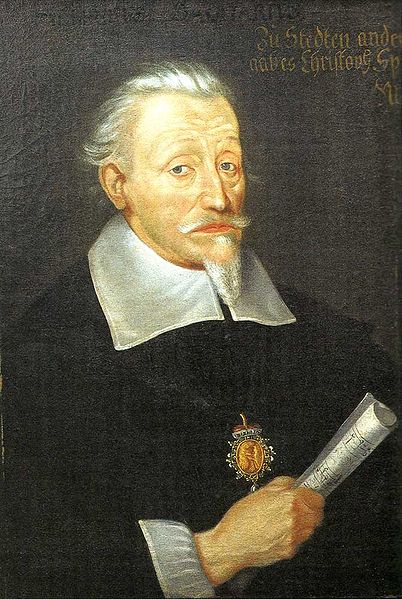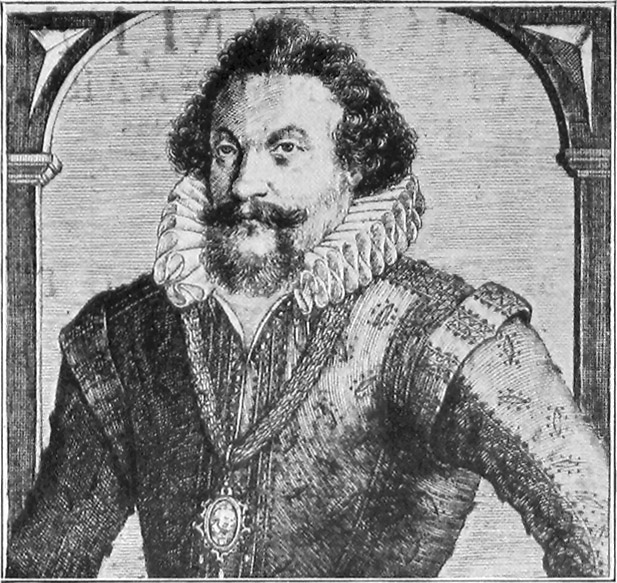<Back to Index>
- Composer and Organist Heinrich Schütz, 1585
- Composer and Organist Samuel Scheidt, 1587
PAGE SPONSOR

Heinrich Schütz (October 8 (JC), 1585 – November 6, 1672) was a German composer and organist, generally regarded as the most important German composer before Johann Sebastian Bach and often considered to be one of the most important composers of the 17th century along with Claudio Monteverdi. He wrote what is thought to be the first German opera, Dafne, performed at Torgau in 1627, of which the music has since been lost. He is commemorated as a musician in the Calendar of Saints of the Lutheran Church on July 28 with Johann Sebastian Bach and George Frideric Handel. He was buried in the Dresden Frauenkirche but his tomb has been destroyed.
He was born in Köstritz, the eldest son of Christoph Schütz and Euphrosyne Bieger. In 1590 the family moved to Weißenfels, where his father Christoph managed the inn "Zum Ring". When Schütz lived with his parents, his musical talents were discovered by Moritz von Hessen - Kassel in 1599. After being a choir boy he went on to study law at Marburg before going to Venice from 1609 – 1612 to study music with Giovanni Gabrieli. Gabrieli is the only person Schütz ever referred to as being his teacher. He also inherited a ring from Gabrieli shortly before the latter's death. He subsequently had a short stint as organist at Kassel before moving to Dresden in 1615 to work as court composer to the Elector of Saxony. In 1619 Schütz married Magdalena Wildeck who had been born in 1601. She bore two daughters before her death in 1625: Anna Justina born in 1621 and Euphrosyne born in 1623.
In Dresden Schutz sowed the seeds of what is now the Sächsische Staatskapelle Dresden, but left there on several occasions; in 1628 he went to Venice again, where he met and studied with Claudio Monteverdi. In 1633 he was invited to Copenhagen to compose the music for wedding festivities there, eventually returning to Dresden in 1635. He again conducted an extended visit to Denmark in 1641. In 1655, the year that his daughter Euphrosyne died, he accepted an ex officio post as Kapellmeister at Wolfenbüttel.
Schutz died in Dresden from a stroke in 1672 at the age of 87.
His pupils included Anton Colander, Christoph Bernhard, Matthias Weckmann, Heinrich Albert, Johann Theile, Friedrich Werner, Philipp Stolle Johann Nauwach, Caspar Kittel, Christoph Kittel, Clemens Thieme, Johann Klemm, Johann Vierdanck, David Pohle, Constantin Christian Dedekind, Johann Jakob Loewe (or Löwe), Johann Kaspar Horn, Friedrich von Westhoff, Adam Krieger, Johann Wilhelm Furchheim, Carlo Farina.
Schütz's compositions show the influence of his teacher Gabrieli (displayed most notably with Schütz's use of resplendent polychoral and concertato styles) and of Monteverdi. Additionally, the influence of the Netherlandish composers of the 16th century is prominent in his work. His best known works are in the field of sacred music, ranging from solo voice with instrumental accompaniment to a cappella choral music. Representative works include his three books of Symphoniae sacrae, the Psalms of David (Psalmen Davids), the Sieben Worte Jesu Christi am Kreuz (the Seven Last Words on the Cross) and his three Passion settings. Schütz's music, while starting off in the most progressive styles early in his career, eventually grows into a style that is simple and almost austere, culminating with his late Passion settings. Practical considerations were certainly responsible for part of this change: the Thirty Years' War had devastated the musical infrastructure of Germany, and it was no longer practical or even possible to put on the gigantic works in the Venetian style which marked his earlier period.
Schütz was one of the last composers to write in a modal style. His harmonies often result from the contrapuntal alignment of voices rather than from any sense of "harmonic motion"; contrastingly, much of his music shows a strong tonal pull when approaching cadences. His music includes a great deal of imitation, but structured in such a way that the successive voices do not necessarily enter after the same number of beats or at predictable intervallic distances. Schütz's writing often includes intense dissonances caused by the contrapuntal motion of voices moving in correct individual linear motion, but resulting in startling harmonic tension. Above all, his music displays extreme sensitivity to the accents and meaning of the text, which is often conveyed using special technical figures drawn from musica poetica, themselves drawn from or created in analogy to the verbal figures of classical rhetoric.
Almost no secular music by Schütz has survived, save for a few domestic songs (arien) and no purely instrumental music at all (unless one counts the short instrumental movement entitled "sinfonia" that encloses the dialogue of Die sieben Worte), even though he had a reputation as one of the finest organists in Germany.
Schütz was of great importance in bringing new musical ideas to Germany from Italy, and as such had a large influence on the German music which was to follow. The style of the north German organ school derives largely from Schütz (as well as from the Dutchman Jan Pieterszoon Sweelinck); a century later this music was to culminate in the work of J.S. Bach. After Bach, the most important composer to be influenced by Schütz was Brahms, who is known to have studied his works.
His major published works contain multiple
pieces of music. Major unpublished works include the Seven Last Words, and the Passions (according to Matthew, Luke, and John). There are over 500 total surviving individual pieces by Schütz.

Samuel Scheidt (baptized 3 November 1587 – 24 March 1654) was a German composer, organist and teacher of the early Baroque era.
Scheidt was born in Halle, and after early studies there, he went to Amsterdam to study with Sweelinck, the distinguished Dutch composer, whose work had a clear influence on Scheidt's style. On his return to Halle, Scheidt became court organist, and later Kapellmeister, to the Margrave of Brandenburg. Unlike many German musicians, for example Heinrich Schütz, he remained in Germany during the Thirty Years' War, managing to survive by teaching and by taking a succession of smaller jobs until the restoration of stability allowed him to resume his post as Kapellmeister. When Samuel Scheidt lost his job because of Wallenstein, he was appointed in 1628 as musical director over three churches in Halle, including the Market Church.
Scheidt was the first internationally significant German composer for the organ, and represents the flowering of the new north German style, which occurred largely as a result of the Protestant Reformation. In south Germany and some other countries of Europe, the spiritual and artistic influence of Rome remained strong, so most music continued to be derivative of Italian models. Cut off from Rome, musicians in the newly Protestant areas readily developed styles that were much different from those of their neighbors.
Scheidt's music is in two principal categories: instrumental music, including a large amount of keyboard music, mostly for organ; and sacred vocal music, some of which is a cappella and some of which uses a basso continuo or other instrumental accompaniment. In his numerous chorale preludes, Scheidt often used a "patterned variation" technique, in which each phrase of the chorale uses a different rhythmic motive, and each variation is more elaborate than the previous one, until the climax of the composition is reached. In addition to his chorale preludes, he wrote numerous fugues, suites of dances (which were often in a cyclic form, sharing a common ground bass) and fantasias.